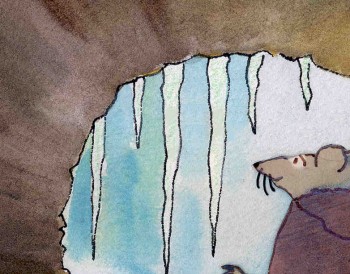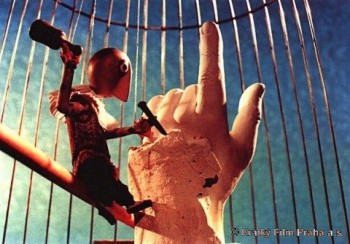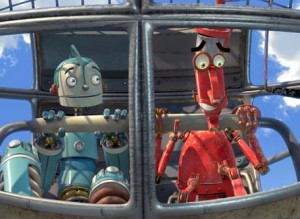Puppet Animation &Trnka 18 Jun 2006 08:31 am
The Hand
As you can tell, from some of my recent postings, I have always had a love affair with puppet animation. There’s something extraordinary about that medium that has drawn me in. I’ve always demanded a tactile approach to animation, including all of the 2D work I’ve done.
 I remember seeing Lady & The Tramp in 1955, on its first release (I was nine.) It was then that I consciously noted that one of the backgrounds in the “Bella Notte” sequence (I can now see that it was an Eyvind Earle BG) had texture in its paper. The board it was painted on came through the animation photography and reached out to me. The human hand became evident in the film.
I remember seeing Lady & The Tramp in 1955, on its first release (I was nine.) It was then that I consciously noted that one of the backgrounds in the “Bella Notte” sequence (I can now see that it was an Eyvind Earle BG) had texture in its paper. The board it was painted on came through the animation photography and reached out to me. The human hand became evident in the film.
Perhaps, this was what I loved so much about animation in the first place. Humans did it, and it was self-evident. Being reminded of it, in the subtlest ways – usually unintentional, added to my joy.
Perhaps this is what brought me to John Hubley’s films. Those films were so obviously painted: characters and BG were both used by the photographer to combine for us, and the unintentional was often caught on screen. (I immediately loved those highlighted rings double-exposed around the characters in Moonbird, the brush strokes of The Hole, the transparency of the characters’ paper in Of Stars and Men.) It added to the experience.
In a sense, I was brought out of the film but held in it and given the opportunity to love it even more.
 I’ve had this same sense with the best 3D animation. Though I was always there viewing it, I was also caught up in the emotions of the film. Trnka’s masterful film, The Hand, had my understanding those tears and sweat on the little potter were moistened ink that had been his painted eyes. But the anguish I felt the first time I saw the film and that effect has never left me. The perfections of the Human Hand in that film forced the imperfections of the puppet potter to be revealed until it destroyed him.
I’ve had this same sense with the best 3D animation. Though I was always there viewing it, I was also caught up in the emotions of the film. Trnka’s masterful film, The Hand, had my understanding those tears and sweat on the little potter were moistened ink that had been his painted eyes. But the anguish I felt the first time I saw the film and that effect has never left me. The perfections of the Human Hand in that film forced the imperfections of the puppet potter to be revealed until it destroyed him.
Perhaps this is also what keeps me from embracing cgi animation. Despite the faked textures of the computer, it’s so obvious that it is not real. At least not when the characters are cartoons.
A very small example of what I’m trying to communicate stands out for me in Cars. The paint job of newer cars has a flecking/speckling of glitter within the paint. In the right light, the main character, Lightning McQueen, had this paint job. Everytime I saw it, I was distracted and pulled out of the film. Like the real paint on a real car, that flecking was embedded within the paint, itself. It didn’t feel like the byproduct of a human hand; it felt like a computer trick.
 I am no more capable of coloring the computer skin of that computer hand than I am of painting a real car. It isn’t tactile for me, it’s just distracting.
I am no more capable of coloring the computer skin of that computer hand than I am of painting a real car. It isn’t tactile for me, it’s just distracting.
It’s just something I never feel I can reach out and touch. This is something that has been overcome, for me, in a couple of films. The Incredibles gets very close often. Moments of Robots, such excellent design for the medium. Some of Toy Story.
(Click on any image to enlarge and enjoy the textures.)
Of course, I recognize that this is my problem. However, I recognize it’s a problem that other people probably have and wonder if there isn’t a solution. In The Iron Giant, the Giant is animated by a computer. I was told that the animation had to be rigged to be animated on “two’s” so that it wouldn’t separate from the rest of the hand-drawn animation. Oddly, it felt totally acceptable to me; I saw no problem and accepted that robot. There has to be, in there, a way to resolve it – I’m just thinking here and don’t expect anyone to try to follow what I’m saying. Perhaps if “human” problems, technical problems, were added to the animation. . . No this is even too stupid for me.

on 18 Jun 2006 at 9:21 am 1.Gabriel said …
Interesting post, Michael. Nice job putting into words what many of us feel but can’t articulate. This talk reminds me of watching Corpse Bride. Call me crazy, but while I liked the film, I thought it was too smooth. I notice a lot of recent stop motion rub me this same way.
But I loved it when I spotted a fingerprint on Gromit’s face.
on 18 Jun 2006 at 6:48 pm 2.Mark Mayerson said …
I wonder if the answer isn’t simply to let more of the artists’ individuality through. Maybe if the computer won’t allow the artist’s hand to be evident, we need to see more of the artists’ minds.
on 19 Jun 2006 at 7:28 am 3.Michael said …
Can you pick out any of the artists who worked on “Cars” other than John Lasseter? Perhaps that isn’t a fair question, but I think cgi is more a director’s medium.
on 19 Jun 2006 at 9:17 am 4.Mark Mayerson said …
I agree with you that cgi is currently a director’s medium but it doesn’t have to be any more than drawn or stop motion. I think it’s a director’s medium by choice.
on 19 Jun 2006 at 12:06 pm 5.Cassidy said …
What an interesting post! This one quote stands out in particular:
‘Perhaps if “human†problems, technical problems, were added to the animation…’
I spent the first ten years of my career in CG doing pretty much exactly what you describe. (Unfortunately I don’t have any animated examples on line, but you can see some stills from one of my shorts here: http://www.otherthings.com/uw/loose/stills.html). Here’s a short abstract I wrote in 1998 that addresses some of the motivation behind this work: http://www.otherthings.com/uw/loose/sketch.html
Of course, the examples above were intended to mimic the feel of hand-drawn animation, but there’s no reason similar techniques can’t be used to give 3D-looking films that sense of having been touched by an artist’s hand.
In fact, I’ve heard that on Aardman’s most recent Wallace and Gromit film, “Curse of the Were-Rabbit”, this may be literally true! Apparently there were dozens of CG bunnies in the film, which were procedurally textured to mimic the fingerprinting effect of the animator’s fingers. On every frame, the body parts that moved were given new fingerprints, whereas the still parts were left alone. The effect is totally seamless. (I certainly couldn’t tell which bunnies were CG, despite repeat viewings!)
There is an entire branch of computer graphics research devoted to these topics, with dozens of professors and hundreds of students all around the world working on different aspects of the problem. I just got back from a conference about it, in fact (http://www.npar.org/2006).
Ultimately, the big difference between CG and traditional animation is that in traditional media, happy accidents occur that enhance that wonderful hand-touched feeling you describe, whereas in CG we must painstakingly add those on purpose. (Not that CG doesn’t have its own accidents and artifacts… it’s just that they are rarely happy ones!
on 21 Jun 2006 at 4:16 pm 6.John Lassetter said …
I disagree. I think that in the world of Cars, with its fantasy of a world run for and by automobiles- a conceit that we’d all have to agree is pure fantasy cartooning- the slickness is what sells the story.
Plus- working in the flaws and foibles of the human hand draws more attention to itself than perfection ever could. I love hand drawn animation, but there are times when the human hand shoves me right out of the story. The crawl on the modeling on the whale’s body in Pinocchio, for example. Opinions vary, but the sloppy (and beautifully so) xerography in 101 Dalmatians, or the hideous (just hideous) rotoscoping technique used occasionally in Cinderella and Sleeping Beauty show that the human hand is sometimes no big deal.
Hey, the human hand gave us the computer.
on 22 Jun 2006 at 7:22 am 7.Michael said …
To the person with the pseudonym “John Lassetter”, rotoscoping does create problems (though the general public usually likes it), but in 2D animation it’s also a fingerprint to the animator. Milt Kahl said, “I took live action on most of the stuff but didn’t pay much attention to it. You’ve got people in the business. You shoot live action and they’ll follow it blindly because it’s a lot easier than thinking.” *
In 2D we know who those animators are, and we can see their work and their laziness. That was the point of what I’d written. I also don’t think that “slickness” ever sells a story that’s any good.
* The quote was taken out of Walt’s People Vol 1 edited by Didier Ghez.